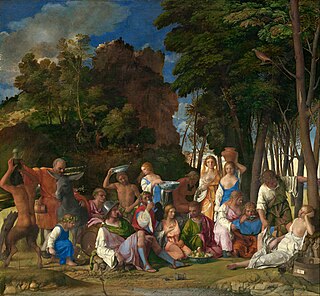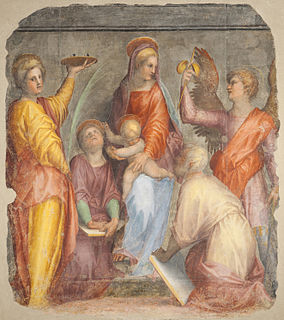 W
WThe Buronzo Altarpiece is a 1514 tempera on panel painting by Gerolamo Giovenone, now in the Galleria Sabauda in Turin, to which it was given in 1836, only a few years after the gallery opened. It shows the Madonna and Child with Saints Abundius and Dominic presenting the work's commissioner Ludovica Buronzo and her sons Pietro and Gerolamo. It is signed and dated by the artist on a small scroll on the base of the throne. It was produced for the Sant'Abbondio chapel in San Paolo church in Vercelli, later passing onto the art market.
 W
WThe Liberation of Saint Peter is a fresco painting by the Italian High Renaissance artist Raphael. It was painted in 1514 as part of Raphael's commission to decorate with frescoes the rooms that are now known as the Stanze di Raffaello, in the Apostolic Palace in the Vatican. It is located in the Stanza di Eliodoro, which is named after The Expulsion of Heliodorus from the Temple. The painting shows how Saint Peter was liberated from Herod's prison by an angel, as described in Acts 12. It is technically an overdoor.
 W
WThe Feast of the Gods is an oil painting by the Italian Renaissance master Giovanni Bellini, with substantial additions in stages to the left and center landscape by Dosso Dossi and Titian. It is one of the few mythological pictures by the Venetian artist. Completed in 1514, it was his last major work. It is now in the National Gallery of Art in Washington D.C., which calls it "one of the greatest Renaissance paintings in the United States".
 W
WThe Fire in the Borgo is a painting created by the workshop of the Italian Renaissance artist Raphael between 1514 and 1517. Though it is assumed that Raphael did make the designs for the complex composition, the fresco was most likely painted by his assistant Giulio Romano. The painting was part of Raphael's commission to decorate the rooms that are now known as the Stanze di Raffaello, in the Apostolic Palace in the Vatican. It depicts Pope Leo IV halting a fire in 847 with a benediction from a balcony in front of the Old St. Peter's Basilica. The mural lends its name to the Stanza dell'incendio del Borgo.
 W
WThe Triumph of Galatea is a fresco completed in around 1514 by the Italian painter Raphael for the Villa Farnesina in Rome.
 W
WHoly Family with the Infant Saint John the Baptist is a small oil on canvas painting, attributed to Correggio and dating to around 1514. It is now in the Los Angeles County Museum of Art, where it has been since 1946.
 W
WMadonna and Child is a 65 by 45 cm oil on canvas painting. It dates to 1512-1514 and is attributed to Correggio but this attribution is uncertain. It was rediscovered in Hohensalzburg Castle in 1928 and given to the Kunsthistorisches Museum in Vienna, where it now hangs.
 W
WThe Madonna and Child with the Infant John the Baptist is a 1513–1514 painting by the Italian artist Correggio.
 W
WThe Madonna dell'Impannata is an oil on panel painting by the Italian High Renaissance painter Raphael. It has been preserved at the Palatine Gallery in Florence.
 W
WThe Madonna della Seggiola or The Madonna della Sedia, oil on panel, 28" in diameter is a Madonna painting by the High Italian Renaissance artist Raphael Sanzio da Urbino, also known as Raphael, and is housed at the Palazzo Pitti Collection in Florence, Italy. Although there is documentation on its arrival to its current location, Palazzo Pitti, it is still unknown who commissioned the painting; however, it has been in the Medici family since the sixteenth century.
 W
WThe Madonna della tenda is a 1514 painting by the Italian renaissance artist Raphael. It shows Mary embracing the child Christ, while the young John the Baptist watches. The design of the painting resembles that of the Madonna della seggiola from the same period.
 W
WMadonna with Child with Young John the Baptist is a painting by the German Renaissance painter Lucas Cranach the Elder, dating from 1514. It is housed in the Uffizi Gallery of Florence.
 W
WThe Malvagna Triptych (1513-1515) is a predella altarpiece by the Flemish artists Jan Gossaert located in the Galleria Regionale della Sicilia, in Palermo, Sicily.
 W
WThe Mass at Bolsena is a painting by the Italian renaissance artist Raphael. It was painted between 1512 and 1514 as part of Raphael's commission to decorate with frescoes the rooms that are now known as the Raphael Rooms, in the Apostolic Palace in the Vatican. It is located in the Stanza di Eliodoro, which is named after The Expulsion of Heliodorus from the Temple.
 W
WThe Meeting of Leo I and Attila is a fresco by the Italian Renaissance artist Raphael. It was painted in 1514 as part of Raphael's commission to decorate the rooms that are now known as the Stanze di Raffaello, in the Apostolic Palace in the Vatican. It is located in the Stanza di Eliodoro, which is named after The Expulsion of Heliodorus from the Temple.
 W
WNativity of the Virgin is a fresco painting by Andrea del Sarto in the Chiostro dei Voti of Santissima Annunziata in Florence. It is signed and dated in 1514, though most of the work on it is thought to have been carried out in 1513.
 W
WNoli me tangere is a c. 1514 painting by Titian of the Noli me tangere episode in St John's Gospel. The painting is in oil on canvas and since the nineteenth century has been in the collection of the National Gallery in London.
 W
WPortrait of a Young Man is a painting by Raphael. It is often thought to be a self-portrait. During the Second World War the painting was stolen by Germans from Poland. Many historians regard it as the most important painting missing since World War II.
 W
WThe Portrait of Henry IV of Saxony and Catherine of Mecklenburg are a matching pair of full-length portrait paintings by the German Renaissance master Lucas Cranach the Elder, dating from 1514, now in the Gemäldegalerie Alte Meister, Dresden, Germany.
 W
WSacred and Profane Love is an oil painting by Titian, probably painted in 1514, early in his career. The painting is presumed to have been commissioned by Niccolò Aurelio, a secretary to the Venetian Council of Ten, whose coat of arms appears on the sarcophagus or fountain, to celebrate his marriage to a young widow, Laura Bagarotto. It perhaps depicts a figure representing the bride dressed in white, sitting beside Cupid and accompanied by the goddess Venus.
 W
WSaint Jerome in Penitence is an oil on panel painting by Lorenzo Lotto, now in the Brukenthal Museum in Sibiu, Romania. It is signed at the bottom left "LAUREN/LOTUS". It is dated to c.1513-1514, early in his time in Bergamo, when he was still clearly influenced by Raphael and other painters active in Rome. It entered the collection of baron Samuel von Brukenthal and remained with his heirs before being confiscated in 1948 and placed in the National Museum of Art of Romania in Bucharest, where it remained until moving to its present location in 2006.
 W
WSaints Peter, Martha, Mary Magdalen and Leonard or Four Saints is a 1514 oil on canvas altarpiece by Correggio, now in the Metropolitan Museum of Art in New York City. He painted it for the church of Santa Maria della Misericordia and it shows Saint Peter, Saint Martha, Mary Magdalene and Leonard of Noblac.
 W
WThe San Gallo Annunciation is a c.1513-1514 oil on panel painting by Andrea del Sarto, now in the Palatine Gallery in Florence.
 W
WThe San Ruffillo Madonna is a c.1514 fresco fragment by Pontormo, originally in the San Ruffillo church in Florence.
 W
WScene from Hospital Life is a c.1514 monochrome fresco fragment by Pontormo, originally in Florence's ospedale di San Matteo, from which it was removed in the 18th century when that building was converted into a museum. It is now in the city's Galleria dell'Accademia.
 W
WThe Sermon of Saint Stephen is an oil-on-canvas by Italian artist of the Venetian school Vittore Carpaccio, painted in 1514. It is now in the Louvre in Paris.
 W
WThe Sybils, or Sybils receiving instruction from Angels, is a painting by the Italian renaissance artist Raphael. It was painted in 1514, as part of a commission Raphael had received from the Sienese banker Agostino Chigi to decorate the interior of Santa Maria della Pace in Rome.
 W
WThe Sistine Madonna, also called the Madonna di San Sisto, is an oil painting by the Italian artist Raphael. The painting was commissioned in 1512 by Pope Julius II for the church of San Sisto, Piacenza. The canvas was one of the last Madonnas painted by Raphael. Giorgio Vasari called it "a truly rare and extraordinary work".